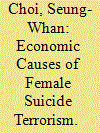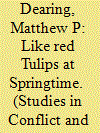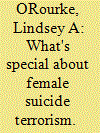|
|
|
Sort Order |
|
|
|
Items / Page
|
|
|
|
|
|
|
| Srl | Item |
| 1 |
ID:
168798


|
|
|
|
|
| Summary/Abstract |
Common belief holds that economic misery motivates more people to commit acts of suicide terrorism. The existing literature, however, fails to find an empirical linkage between these two phenomena. This study offers a novel theoretical perspective and statistical evidence on the economy and terrorism connection. I argue that Muslim women decide to engage in acts of suicide terrorism because of their perception of the national economy, rather than actual economic conditions such as gross domestic product per capita or the Gini index. Based upon a statistical analysis of 4,495 incidents of suicide terrorism during the period from 1981 to 2015, the study shows that, when Muslim women perceive their national economy to be unfavorable, they are more likely to commit acts of suicide terrorism.
|
|
|
|
|
|
|
|
|
|
|
|
|
|
|
|
| 2 |
ID:
099787


|
|
|
|
|
| Publication |
2010.
|
| Summary/Abstract |
In an era where female suicide terrorism is on the rise in conflict regions such as the Middle East, the North Caucasus, and South Asia, why has Afghanistan been largely immune to this trend? Why do some violent groups use female suicide terrorism and others avoid it? This is a critical question for policy makers and analysts attempting to understand a dangerous terrorist phenomenon and how it may evolve in Afghanistan. During the anti-Soviet jihad, narratives were woven of men and women marching through the mountains of Nuristan to "offer their blood for the Islamic revolution like red tulips at springtime." But today, women are wholly absent from the Taliban and their jihad in Afghanistan. This article analyzes, in particular, the absence of women in Taliban martyrdom operations. There are three primary findings from this study that explain the low propensity for female suicide bombers in Afghanistan. First, a permissive social and geographic environment in Afghanistan gives insurgents freedom of mobility and a resistance capacity characterized by a reduced necessity for female suicide bombers; second, the capacity of a fiercely conservative culture restricts female participation in both Afghan society and within insurgent organizations; and third, the pronounced absence of a female culture of martyrdom limits women from participation in insurgent actions and narratives.
|
|
|
|
|
|
|
|
|
|
|
|
|
|
|
|
| 3 |
ID:
092888


|
|
|
|
|
| Publication |
2009.
|
| Summary/Abstract |
This study analyzes the interaction between the motivations of individual attackers and terrorist group strategies. To do so, I combine a quantitative analysis of all known suicide terrorist attacks between 1981 and July 2008 with a strategic account of why terrorist organizations employ female suicide terrorism (fst) and case studies of individual female attackers. I advance five central claims. First, I reveal the superior effectiveness of fst from the perspective of the groups that employ women. Second, I explain that terrorist groups increasingly enlist women as suicide attackers because of their higher effectiveness. Third, I demonstrate that terrorist groups adapt their discourse, catering to the specific individual motives of potential female suicide attackers in order to recruit them. Fourth, I show that female attackers are driven by the same general motives and circumstances that drive men. Furthermore, and in contrast to the existing literature, women attackers uphold, rather than eschew, their societies' norms for gender behavior. Attempts to transform these societies into gender-neutral polities are therefore destined to increase fst. Finally, I conclude that, unless target states adapt their defensive strategies, we should expect an increase in fst.
|
|
|
|
|
|
|
|
|
|
|
|
|
|
|
|
|
|
|
|
|